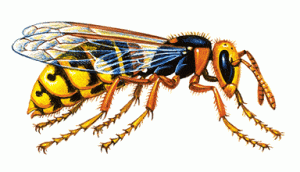Control of wasps

Everyone knows wasps. Almost everyone has heard its annoying buzzing and many have experienced its fiery roar. The wasp is a troublesome, sometimes downright dangerous and in any case a complete nuisance.
Nest locations: attics, attics, eaves and garages are the main nesting sites.
Life cycle: during the summer, a wasp family can grow to several hundred members.
Frequency of treatments: as needed.
Damage caused: The bite of a common wasp is less dangerous than that of a bee. If a bee dies after stinging, wasps sting repeatedly and nothing happens to them. Even the most tolerant of wasp venom will develop an inflammatory swelling at the site of the sting: the temperature around the wound rises and swelling develops for a few hours or even a day. Even the slightest reaction can be lethal!
Conditions for control: Wasp control can only be carried out in complete darkness.
Mistakes that are made: Stirring up a wasp’s nest indoors is a dangerous activity.
The tools we use and how quickly they take effect: If the nest is visible, it is crushed and if possible removed from the site in a sealed plastic bag, wet control is carried out in the room and the result of the control is rapid.
However, if the nest is located in an inaccessible place (especially in the case of quacks), it is possible to carry out a wet treatment in the eaves of the building and it will take a few days to achieve a control result.
